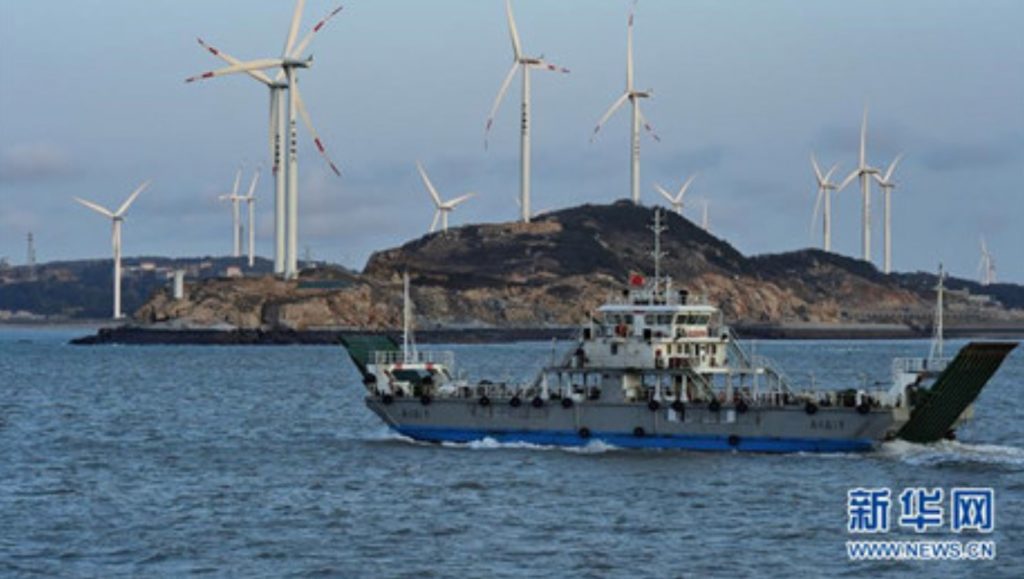Window-to-China
Overview of last view News
Industrial-scale aquaculture may reduce methane and NOx emissions by 40 %
Global consumption of fish for food increases by an annual 3.2 % and production is mostly carried out by extensive or semi-intensive aqua farming, leading to methane and NOx emissions (1.82 % and 0.34 %, respectively, of global emissions). China is among the major countries involved in such type of aquaculture. Investigations by DING Weixin and colleagues from the CAS Institute of soil sciences suggest that if such systems could be replaced by intensily managed aquaculture farms based on efficient aeration, optimized feeding and reduced feed waste, emissions might be cut by 40 %.
CAS news release, May 15, 2019
CAS team reports progress in calcium-ion batteries
The group of Yongbing TANG at CAS Shenzhen Institutes of Advanced Technologies has reported on a new type of calcium ion batteries (CIB) which uses activated carbon as anode and tin as a cathode. Reportedly this CIB has a good rate and cycling performance as well as high capacity and working voltage, and it retained 84 percent of its initial capacity after 1,000 cycles at room temperature.
CAS news release, March 13, 2019
Ingestion of pesticides may lead to obesity: Chinese study with mice
When the group around WANG Peng from China Agriculture University added chlorpyrifos pesticide into the food and water of mice, they found an increase in body weight. They assume that pesticide intake broke the integrity of the gut barrier, leading to an increased entry of a toxin into the body and finally inflammation, which ultimately induced insulin resistance and obesity. Similar results were observed in mice with different genetic backgrounds and diet habits, suggesting that genes and diet had limited influence on the altered gut and gut microbiota.
CAS news release, March 8, 2019
Nearly 90 percent of Chinese are optimistic about the use of AI
In a recent survey among 2,006 people by China Youth Daily and a leading Beijing-based AI company, 89.4 percent of respondents were optimistic about using AI technology over the next five years. Among the respondents, 53.7 percent were most familiar with automated driving, 53.4 percent with intelligent robots, and 44.8 percent with intelligent home appliances. In the survey, 49.3 percent of respondents felt that the most likely replacement for a job by AI were waiters, followed by secretaries (42.3 percent) and security personnel (40.2 percent). In contrast, the profession of journalists was rated the least replaceable in the survey.
Xinhua net Germany, March 8, 2019
Gut microbiota may help to maintain body temperature
It is known that during cold exposure animals sustain their body temperature by activating heat production from Brown Adipose Tissue (BAT), promoting “browning” of white adipose tissue. As shown in mice experiments by John R Speakman, CAS Institute of Genetics and Developmental Biology, groups of gut microbiota where eradicated using different antibiotics. The animals lacking gut microbiota showed impaired thermoregulation. The results where corroborated in germ-free mice. The effect could be because, in the absence of an intact microbiome, the animal is unable to digest sufficient quantities of food to meet elevated energy demands in the cold, and the impact on BAT is a secondary effect. However, the team also showed that addition of the bacterial metabolite butyrate increased the thermogenic capacity of antibiotic-treated mice. This suggests that microbiota plays an important signaling role in the process that stimulates cold-induced thermogenesis.
CAS news release, March 6, 2019

Chinese-French joint-venture for the development of airships
The French enterprise Flying Whales located in Suresnes has developed an airship LCA6oT (“Flying Whale”) for the transport of heavy, high-volume loads over shorter distances at low cost. The Chinese AVIC General keeps 24,9 % of shares of this company. People’s Daily is now reporting that Jingmen, Hubei Province, is building an assembly line for such airships for the world market. They could transport goods such as wood or wind turbines.
People’s Daily German edition, March 5, 2019

“Internet Status Report” sees close to 40 million internet domains in China
The 43d Chinese Internet Development Status Report published in Beijing on February 28 counted over 800 million internet users and 37,9 million internet domains by the end of 2018. Net users spent an average of 27.6 hrs per week on the internet.
Japan JST China news, March 1, 2019
Study finds abundant microplastics in Poyang Lake, China’s biggest lake
Poyang Lake, Xinjiang Province, is China’s biggest freshwater lake measuring 3500 km2. It provides a habitat for half a million migratory birds. A study investigating the microplastic pollution in water, sediment, and fish samples of Poyang Lake and supported by CAS found that microplastics are abundant and ubiquitous in the lake. The majority of the detected microplastics were found with a size of <0.5 mm, with fibrous and colored being the predominant characteristics. Polypropylene (PP) and polyethylene (PE) were the major polymer types. Fishing activities and domestic sewage can be the major contributors of the microplastic abundance in Poyang Lake. In addition to human activities, the distribution pattern of microplastic contamination of Poyang Lake may be also affected by hydrodynamic and topographic conditions.
CAS news release, March 1, 2019
Future profession “drone pilot” – the Chinese Ministry of Human Resources defines 15 new curricula
Recently, the Ministry of Human Resources and Social Security has released 15 new job titles, which relate to future developments in artificial intelligence, big data and other technical advances. Examples are:
- Engineer for artificial intelligence
- Engineer for Internet of Things
- Engineer for big data
- Engineer for cloud computing
- Engineer for building information modelling
- E-sports operator
- Drone driver
The Ministry expects that recognition of new professions will encouraging people to acquire and practize relevant skills.
Xinhua Net, February 27, 2019
(reference by Xin XIONG)
China plans for stratospheric photovoltaic power plants
Researchers from Chongqing University, the China Academy of Space Technology’s Xi’an Branch, and Xidian University also in Xi’an have started construction of the first space base for an experimental solar power station in Chongqing. They plan to launch four to six tethered balloons, connect them with each other to set up a network at an altitude of around 1,000 meters. The balloons will collect sunlight and convert solar energy to microwaves beamed back to earth. Receiving stations on the ground will convert the microwaves to electricity which is distributed to a grid. The test facility will occupy 13.3 ha and demonstrate space transmission technologies while studying the effect of microwaves beamed back to Earth on living organisms. The engineers will need to resolve two major technical difficulties: accurate, directed transmission of high-capacity microwaves (so far possible over a distance of about 100 m only), and construction of a large space-based power station whose size and weight has yet to be determined. If these challenges can be tackled, a small to medium-sized stratospheric photovoltaic power plant will be built between 2021 and 2025. After 2025, larger-scale space photovoltaic power plant systems will be investigated. The long-term goal is to establish a Gigawatt commercial photovoltaic power plant in space by 2050.
CAS news release, February 26, 2019

Putian builds “wind power island”
The city located in Fujian Province near the Taiwan strait has built 138 wind power generaters on islands sourrounding the city. Electricity generated enters the Putian power grid.
Japan JST China news, February 26, 2019

Deep space exploration: China studies solar sails made from graphene
According to CHEN Yonghsheng of Nankai University, graphene can be driven by light sources such as sunlight, and the thrust generated in vacuum conditions is 1,000 times higher than that of polyimide film, studied by Western researchers for “solar sails”. Graphene is among the strongest and thinnest known materials, and can withstand temperatures over 800 degrees centigrade.
CAS news release, February 25, 2019
Bronchioalveolar stem cells (BASCs) assist in lung repair and regeneration: CAS Institute of Biochemistry and Cell Biology
In cooperation with CAS Guangzhou Institute of Biomedicine and Health, the group of JI Hongbin found by fate-mapping and clonbal analysis of BASCs that this cell type can become become activated by different lung injuries, and can differentiate into multiple cell lineages including club cells, ciliated cells, and alveolar type 1 and type 2 cells for lung regeneration. Thus BASCs show multipotency and self-renewal during lung repair and regeneration.
CAS news release, February 22, 2019
Metabolic engineering of Myceliophtora thermophila provides high titers of fumaric acid
A group around Shuying GU and Jingen LI at CAS Tianjin Institute of Industrial Biotechnology has engineered Myceliophthora thermophila using the CRISPR/Cas9 system. They introduced fumarase of Candidakrusei fumarase into M. thermophila and disrupted the intracellular fumarate digestion pathway by deletion of the two fumarate reductase and the mitochondrial fumarase genes of M. thermophila. Increasing the pool size of malate, the precursor of fumaric acid, significantly increased the final fumaric acid titer. Finally, disruption of the malate–aspartate shuttle increased the intracellular malate content. The final strain could produce up to 17 g/L fumaric acid from glucose in a fed-batch fermentation process.
CAS news release, February 22, 2019

Chongqing Oilfield provides China with 121 million m3 of gas per day
China’s largest oil field supplies gas to over 40 Chinese cities including Xi’an and Beijing by a total of 5600 km of pipelines. In 2018, production reached over 38 billion m3, accounting for a quarter of China’s overall production.
Japan JST China news, February 22, 2019
Beijing leads China in AI-related industry
According to a “White paper on the development of AI Industry in Beijing”, there were over 4000 AI-related companies in China by mid-2018, 1070 of which were located in Beijing. In automatic driving, 35 vehicles made by 8 companies did cover already over 63,000 km road tests.
Japan JST China news, February 20, 2019
China emphasizes clean coal thermal power supply systems
According to a report by the China’s National Energy Board, by October 2018 ultra-low emission coal-fired power generation equipment in China reached over 700 million kW. Due to ultra-low emissions and energy savings, annual emissions of sulfur dioxide, nitrogen oxide and flue dust in China’s coal-fired power generation industry has drastically decreased since 2014, and standard coal usage for power supply also tends to decrease.
Japan JST China news release, February 14, 2019
Xiamen University team develops humanized mouse model for hepatitis B
Previous studies had shown that mesenchymal stem cells from human bone marrow have the potential to differentiate into hepatocyte-like cells in vitro and continue to maintain essential hepatocyte functions after being transplanted into host mouse livers. After HBV infection, the humanized mice developed specific immune and inflammatory responses and showed progression to chronic hepatitis and liver cirrhosis, providing opportunities for better understanding the immune pathophysiology of HBV and testing promising antiviral therapies in vivo. According to WHO, an estimated 257 million people are living with HBV infection, and over 100 million among them in China.
CAS news release, February 12, 2019
China attempts to green the Kubuqi desert in Inner Mongolia
Over the past 30 years, planting shrubs and trees led to greening of over 6000 square kilometers of this desert. Carbon sequestration is now 15.4 million tons, water source recharge is 24,376 million cubic meters, and oxygen release about 18.3 million tons. The region located in Inner Mongolia is now a United Nations “World Ecological Economic Demonstration Area”, and NASA, based on satellite images, recognized China’s “Outsized Contribution” to global greening trends. China at present accounts to 1/4th of the world’s greening expansion area.
China Daily, February 12, 2019

Metal-free photocatalyst destroys E. coli in water in 30 minutes
A team from Yangzhou University, CAS Institute of Process Engineering and the University of Technology in Sydney has developed a mthod which killed model Escherichia coli under visible-light irradiation within 30 min, by using an edge-functionalized graphitic carbon nitride (g-C3N4) as the photocatalyst. The authors believe that edge functionalization generated an anisotropic electric field that promoted the separation of photo-generated electron-hole pairs, leading to disruption of membranes. The method may eventually be used to prepare pathogen-free water by photocatalysis.
CAS news release, February 8, 2019
